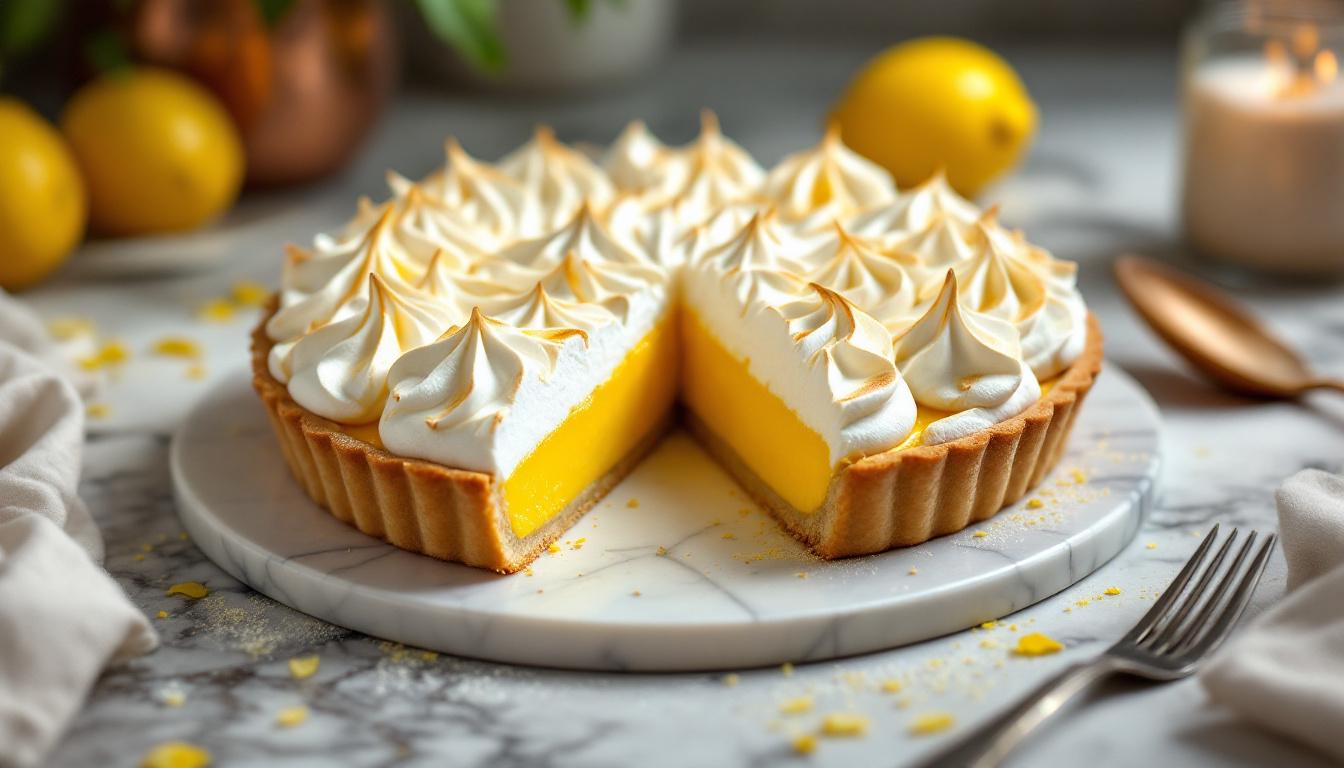The first time I tasted an authentic Tarte au Citron Meringuée was in a tiny patisserie in southern France. What struck me wasn’t just the perfect balance between sweet and tart, but the textural symphony – a buttery crust yielding to silky lemon curd, crowned with clouds of meringue that managed to be both ethereal and substantial. It’s a classic that deserves respect but welcomes personal touches. I’ve spent years refining this recipe, and I’m thrilled to share my version that honors tradition while incorporating techniques that ensure foolproof results every time.
The Story
This French lemon meringue tart traces its origins to the sun-drenched Mediterranean coast, where citrus groves flourish. Unlike its American cousin, the French version features a more pronounced lemon flavor and a sturdier, less sweet curd. The traditional approach requires patience, particularly when creating the silky curd that should coat a spoon perfectly without a hint of graininess. During my stint at a Provençal restaurant, an 80-year-old pastry chef taught me that the secret lies in the gentle cooking of the curd – “slow like love, not fast like infatuation,” she would say while demonstrating the careful stirring technique that prevents the eggs from scrambling.
Ingredients Spotlight
For the shortcrust pastry:
- 1⅔ cups (200g) all-purpose flour
- 7 tablespoons (100g) cold unsalted butter, cubed
- 1 pinch salt (about ¼ teaspoon)
- 3 tablespoons (50ml) ice water
For the lemon filling:
- 4 whole eggs plus 1 extra yolk
- 1 cup (200g) granulated sugar
- ⅔ cup (150ml) fresh lemon juice (about 4-5 lemons)
- Zest of 1 unwaxed lemon
- 5½ tablespoons (80g) cold unsalted butter, cubed
For the meringue:
- 3 egg whites, at room temperature
- 1 cup (200g) granulated sugar
- ½ teaspoon white vinegar or cream of tartar
Step-by-Step Guide
1. Prepare the pastry:
- Combine flour and salt in a large bowl, then work in the cold butter with your fingertips until the mixture resembles coarse breadcrumbs.
- Gradually add the ice water, mixing until just combined – don’t overwork the dough.
- Form into a disk, wrap in plastic, and refrigerate for 1 hour.
- Roll the dough to a 3mm thickness and line a 9-inch (23cm) tart pan. Prick the bottom with a fork.
- Line with parchment and fill with baking weights. Blind bake at 350°F (180°C) for 15 minutes, then remove weights and paper and bake for another 5 minutes until lightly golden.
2. Make the lemon filling:
- In a heatproof bowl, whisk together eggs, egg yolk, sugar, lemon juice, and zest.
- Place over a saucepan of simmering water (bain-marie) and cook, stirring constantly, until the mixture reaches 175°F (75°C) and thickens enough to coat the back of a spoon.
- Remove from heat and whisk in cold butter pieces until fully incorporated and the curd is glossy.
- Pour into the pre-baked tart shell and smooth the surface.
3. Create the meringue:
- Beat egg whites with vinegar until soft peaks form.
- Gradually add sugar, continuing to beat until stiff, glossy peaks form – the meringue should feel smooth, not grainy, when rubbed between your fingers.
- Spread or pipe the meringue over the lemon filling, making sure it touches the pastry edges to prevent shrinking.
- Create decorative peaks with the back of a spoon or piping bag.
4. Finish the tart:
- Preheat oven to 400°F (200°C).
- Bake for 5-7 minutes until the meringue peaks are golden brown – watch carefully to prevent burning.
- Cool the tart completely before slicing with a knife dipped in hot water.
Expert Techniques
The success of this tart lies in the details. When cooking the lemon curd, use a silicone spatula to constantly scrape the bottom and sides of the bowl, preventing any egg from overcooking. The curd is ready when it reaches that magical 175°F (75°C) mark – invest in a good thermometer if you’re serious about pastry.
Chef’s Note: For the most stable meringue, ensure your mixing bowl is completely free of grease. I wipe mine with a halved lemon before starting – the acid helps remove any residual fat that could prevent proper whipping.
For the meringue, add the sugar in three stages rather than all at once. This creates a more stable structure with smaller air bubbles, resulting in that professional, glossy finish. And don’t rush – properly incorporating the sugar takes at least 5-7 minutes of beating.
Presentation & Pairing Ideas
Serve this tart at room temperature for the perfect texture contrast. A light dusting of powdered sugar just before serving adds an elegant touch. For a contemporary twist, garnish with paper-thin candied lemon slices or a scattering of fresh berries.
Wine pairing is crucial here – look for something that echoes the tart’s balance of sweetness and acidity. A Muscat de Beaumes-de-Venise works beautifully, as does a late-harvest Riesling. If you prefer non-alcoholic options, a sparkling elderflower cordial offers similar complementary notes.
For a complete French-inspired meal, serve this tart as the finale after a classic Beef Bourguignon or follow a lighter Mediterranean pasta salad for a balanced menu.
Make this tart your own by experimenting with different citrus – blood orange in winter or Meyer lemon when available create subtle but delightful variations. For a dinner party showstopper, try individual tartlets with different colored curds – perhaps adding a touch of passionfruit to some for a tropical twist. Remember, recipes are roadmaps, not rulebooks – the kitchen is where your creativity truly shines! 🍋✨
